中国组织工程研究 ›› 2017, Vol. 21 ›› Issue (2): 238-243.doi: 10.3969/j.issn.2095-4344.2017.02.014
• 复合支架材料 composite scaffold materials • 上一篇 下一篇
肌腱细胞与聚二甲基硅氧烷多孔材料复合培养后的玻璃化低温保存
王 治1,2,谭美云2,卿 泉1,陈 曦1,3,刘成俊1,4,秦廷武1
- 1四川大学华西医院生物治疗国家重点实验室,四川省成都市 610041;2西南医科大学附属医院骨与关节外科,四川省泸州市 646000;3德阳市人民医院,四川省德阳市 618000;4成都市第一人民医院,四川省成都市 610041
Vitreous cryopreservation of tenocytes co-cultured with porous polydimethylsiloxane scaffolds
Wang Zhi1, 2, Tan Mei-yun2, Qing Quan1, Chen Xi1, 3, Liu Cheng-jun1, 4, Qin Ting-wu1
- 1State Key Laboratory of Biotherapy, West China Hospital of Sichuan University, Chengdu 610041, Sichuan Province, China;2Department of Bone and Joint Surgery, the Affiliated Hospital of Southwest Medical University, Luzhou 646000, Sichuan Province, China; 3Deyang People’s Hospital, Deyang 618000, Sichuan Province, China; 4Chengdu First People’s Hospital, Chengdu 610041, Sichuan Province, China
摘要:
文章快速阅读:
.jpg)
文题释义:
深低温保存:是由常温到低温(5-0 ℃),再到深低温(-196 ℃)的过程及相反的升温过程,短时间内,5-0 ℃对细胞仅造成轻微损伤。常温下,细胞生理活动在细胞内的脂膜系统区隔下完成。温度变低会引起细胞膜脂相变,进而导致细胞膜完整性破坏,细胞通透性改变。
玻璃化低温保存:是一种新的低温保存方法,玻璃化意指水在降温时因为玻璃化保存剂的存在,阻止了水分子结晶,在冰点以下形成类似玻璃一样的非结晶固态结构,玻璃化低温保存得以实现的前提是冻存剂必须达到较高的浓度,在玻璃化状态下,生物大分子被未结晶的水分子和冻存保护剂分子包围,能长时间保持生物大分子的结构和功能,这是玻璃化低温保存得以实现的物理化学基础。
背景:大量实验已证明,玻璃化低温保存能获得更高的细胞存活率。
目的:观察玻璃化低温保存对肌腱细胞与聚二甲基硅氧烷材料复合物的影响。
方法:取共培养9-14 d的肌腱细胞-聚二甲基硅氧烷复合物,分别以10%二甲亚砜、玻璃化低温保存液VS55、21%二甲亚砜进行低温保存和复苏。复苏培养1 h后,进行死/活双色荧光染色和流式细胞技术分析,观察肌腱细胞存活率,以新鲜培养的肌腱细胞-聚二甲基硅氧烷复合物为对照。
结果与结论:①死/活双色荧光染色:10%二甲亚砜组肌腱细胞从聚二甲基硅氧烷支架材料孔隙表面上剥脱,呈双染的不规则细胞形态;VS55组和21%二甲亚砜组存在单染绿色荧光的梭形和球形细胞,也存在红绿双染的不规则形态细胞,两组细胞观测密度较对照组明显下降;②流式细胞技术分析:对照组细胞大小均匀;10%二甲亚砜组由于细胞量少而不足以进行流式细胞检测;VS55组以较小体积的细胞颗粒为主;21%二甲亚砜组细胞体积大小与新鲜对照组类似,同时存在较小颗粒;③细胞回收率与存活率:VS55组细胞相对存活率低于21%二甲亚砜组(64.9%,76.2%,P < 0.05);10%二甲亚砜不能获取足够细胞,未能行细胞计数;④结果表明:采用21%二甲亚砜玻璃化低温保存有利于提高细胞的存活率,保持肌腱细胞-支架结合完整。
orcid.org/0000-0001-9871-4375ORCID: 0000-0001-9871-4375(王治)
中图分类号:
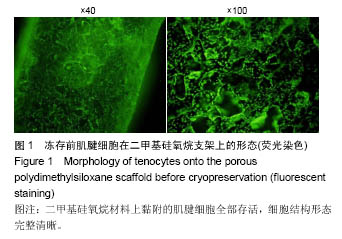

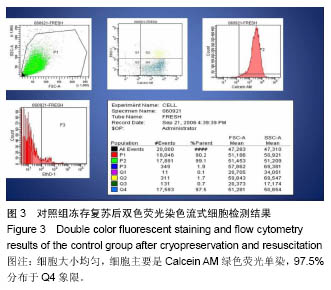
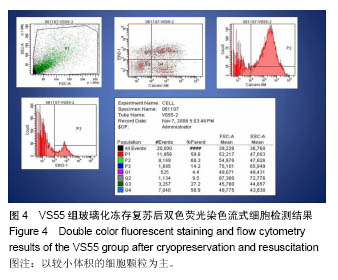
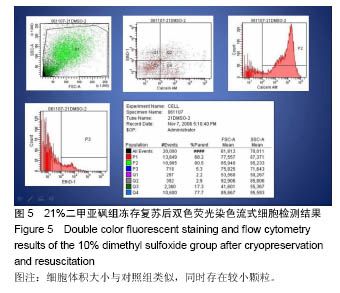
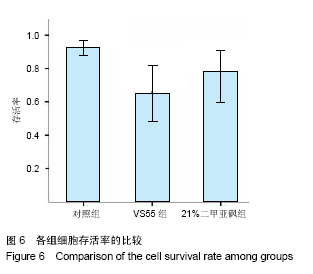
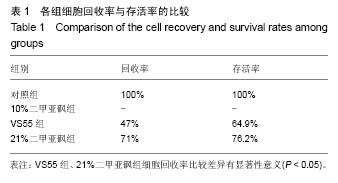
.jpg)